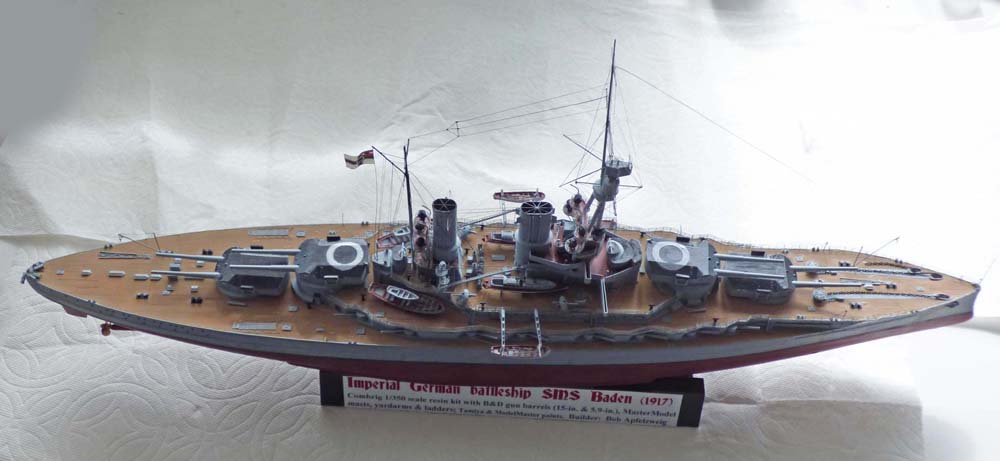
1/350 Imperial German battleship Baden (Combrig)
|
by Robert Apfelzweig |

1/350 Imperial German battleship Baden (Combrig)
The Baden and its sistership (or, in German, brother ship) Bayern were the last and finest battleships of Kaiser Wilhelm's navy; unfortunately for Imperial Germany, they were completed too late for Jutland, saw little action and were both interned with most of the High Seas Fleet at Scapa Flow after the end of World War I, only to be scuttled (at least partially) in the German navy's mass suicide of July 1919. The Baden was saved from complete sinking by quick action of the British Navy, and subsequent analysis of the ship showed it compared very favorably with, and in some respects was superior to, the contemporary Queen Elizabeth and R class superdreadnoughts. Baden was subsequently sunk in 1921 as a target ship.Combrig's resin model of the Baden leaves quite a bit to be desired -- or scratch-built, as the case may be. While the parts are generally excellent in themselves, there aren't enough of them -- the single brass photoetch fret is rather primitive and wholly 2-dimensional; the ladders (of only one size and not enough regardless) are not well-cast and no railing is provided (I used a spare set from Eduard, and Flyhawk German ladders). The feeble assembly instructions give only general locations of various parts (none of which are numbered) and no masts or yardarms are provided. Dimensions for these "self-made" parts are given, but the instructions don't clearly indicate which rods of which length go where. Consequently, I purchased the Kagero "Battleship SMS Baden in 3D" book, which gives a very detailed collection of CAD color plates and a an extensive history of the ship. These plates, however, come with a major drawback (at least in the 2017 edition I have) -- most, if not all, are mirror images of what they should be. For example, the Baden had 2 port bow anchors an one starboard bow anchor; the book's very vivid images show just the opposite. As long as the features you are looking at are symmetrical from port to starboard, you have no problem, but the builder should rely on the vague pictures in the assembly instructions for where to put such asymmetrical features as barbette ventilators. I used 2.2 mm brass rod for the tripod struts (the multiple bridge platforms and tripod struts must be assembled simultaneously -- no easy task) and Master Model brass masts and yardarms. The Kagero book at least provided information on certain details omitted by the Combrig kit -- such that, while up to eleven small boats and motor launches could be carried, only 4 to 6 were ever shipped, and although the kit supplied eight 88 mm shielded AA guns, only four were actually mounted on the ship. Kagero also showed the positioning of numerous narrow struts in the bridge superstructure (also omitted by Combrig). The Combrig instructions do have a fairly decent rigging display but it was only from the starboard side; since most of the rigging was symmetrical, I used the very detailed images in the Kagero book. I also had to scratch-build the forecastle and quarterdeck torpedo loading equipment and the lattice supports (omitted by Combrig) for the main bridge wings, which are too narrow. I used B&D brass 15-in. and 5.9-in. gun barrels; all very well-made but the former are at least 1 cm too long, requiring me to drill deeply into the turret fronts to correctly position them. I used ModelMaster dark and light ghost grey for the upper hull and superstructure; rigging was from stretched black plastic sprue. An interesting feature of the Baden was that, since the secondary gun barrels were placed so close to the deck, the safety railing for much of the ship's hull was not normally visible during combat sorties -- the stanchions and cable railings collapsed close to the deck so as to become nearly invisible -- a convenient way to avoid installing them on this model.
